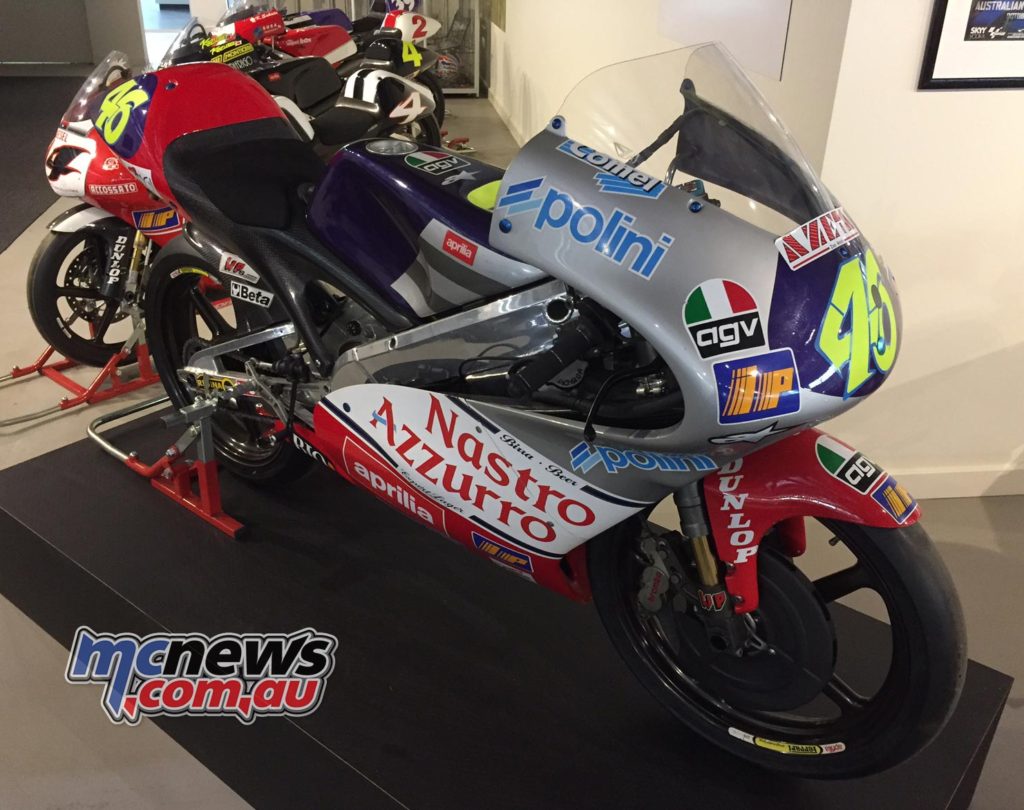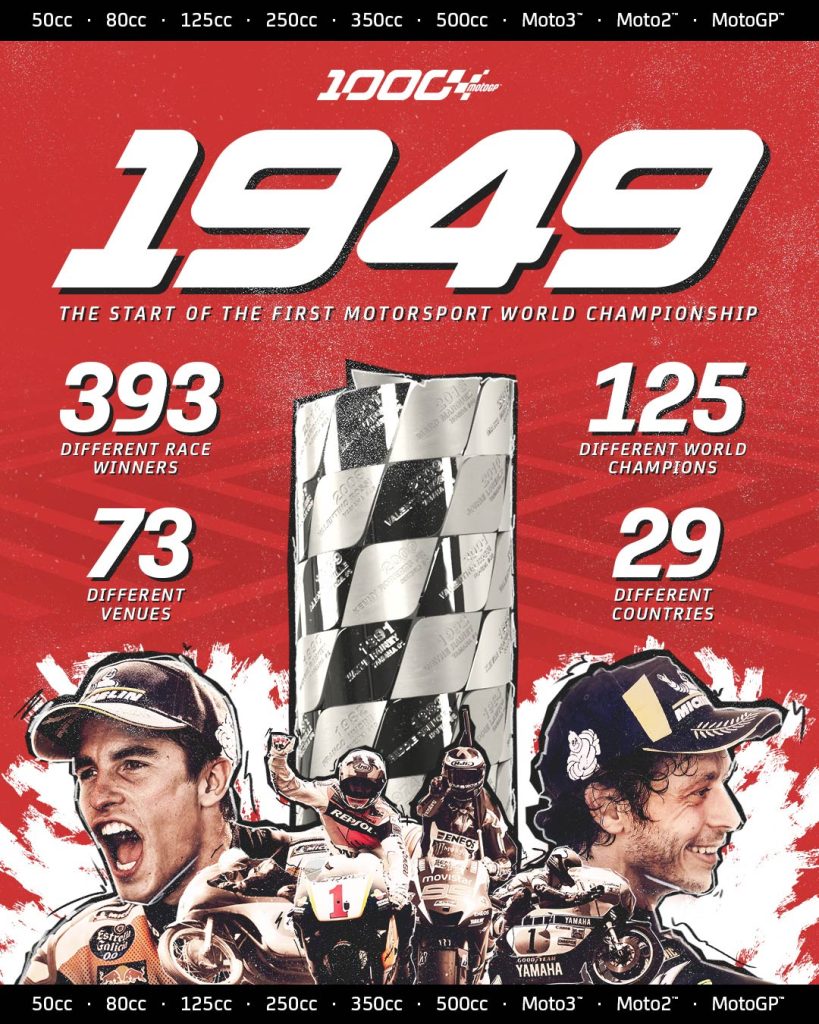Le Mans to host 1000th GP
This weekend Le Mans will host the 1000th Grand Prix in history. Here are some stats for the occasion!
1949 – The Grand Prix World Championship was introduced in 1949 with four classes for solo motorcycles: 500cc, 350cc, 250cc and 125cc. The very first race counting towards a World Championship classification was the 350cc race on Monday June 13th 1949 on the Isle of Man, won by Freddie Frith on a Velocette.
817 – Honda is the most successful manufacturer in GP racing with 817 wins ahead of Yamaha (520), Aprilia (295), MV Agusta (275), Kalex (165) and Suzuki (162).
432 – Valentino Rossi is the rider with most GP starts: 432, meaning he’s raced in more than 43 per cent of all the Grands Prix that have taken place.

393 – From the very first race in 1949 to the 2023 Spanish GP, 393 different riders have stood on the top step of the podium. The most recent “new winner” is Ivan Ortola in Moto3™ in Austin this year.
235 – Valentino Rossi is the rider with the most podiums with 235, ahead of Giacomo Agostini (159), Dani Pedrosa (153), Jorge Lorenzo (152), Angel Nieto (139) and Marc Marquez (139).
125 – 125 different riders have clinched a Grand Prix World Championship, taking a total of 284 titles. Giacomo Agostini holds the record with 15, ahead of Angel Nieto (12 + 1), Mike Hailwood (9), Rossi (9) and Carlo Ubbiali (9).
122 – Agostini is the most successful rider with 122 GP wins ahead of Rossi (115) and Nieto (90). Marc Marquez is fourth with 85 wins, ahead of Hailwood with 76.
73 – Assen is the venue that has hosted the most Grands Prix. It held an event every year since the World Championship started back in 1949, until 2019. The 2020 Dutch TT was then cancelled due to the pandemic, making it 73 Dutch TTs so far counting towards the World Championship.
73 – Since 1949, 73 different circuits have hosted a premier class Grand Prix; Mandalika is the most recent addition, joining the calendar in 2022.
30 – Since 1949, 30 different manufacturers have clinched Grand Prix World titles. Honda leads with 72 titles ahead of Yamaha (37), MV Agusta (37), Aprilia (19) and Suzuki (15).
29 – 29 countries have hosted at least one Grand Prix since 1949. Spain leads with 143 ahead of Italy on 103.
29 – 29 nationalities have won Grands Prix. Italy leads with 876 wins ahead of Spain (700) and the UK (413).
20 – There were six GPs in 1949, all in Europe. 20 GPs are now scheduled in 2023, in 17 different countries.
19 – 19 nationalities are represented in the 125 World Champions crowned since 1949. Italy leads with 80 world titles ahead of Spain (57) and the UK (45).
1 – Of the 125 Champions, 70 (more than half) have clinched only one title – but 55 are multiple World Champions.
Some things that happened along the way…
The Isle of Man TT races were first established as a non-championship event in 1907, and as part of the event on Monday 13th June 1949 the very first race which counted towards the World Championship took place, a 350cc contest won by British rider Freddie Frith riding a Velocette. The other categories that were included in the first TT event in 1949 were the 250cc & 500cc classes, categories which have now evolved into the modern Moto2 and MotoGP World Championships.
British manufacturers such as AJS and Norton enjoyed success in the early days of the World Championship, before the Italian manufacturers Mondial, Moto Guzzi, Gilera and MV Agusta began to dominate during the 1950s, reflecting the strength of the country’s motorcycle industry at the time. MV Agusta were particularly prolific late in the decade, taking a clean sweep of World titles across all four categories for three seasons from 1958 to 1960 – while their dominance in the 500cc class was unbroken for 17 years from 1958 until 1974.
The most successful rider during the years 1949 to 1976 when the TT was still part of the World Championship series was Mike Hailwood, who took 12 TT victories, including winning the 125cc, 250cc & 500cc class in 1961 to become the first rider to win three different classes at a single World Championship event.
During the 1960s many of the Japanese manufacturers that participate in modern day MotoGP racing, such as Honda and Yamaha, arrived to pick up their first World Championship title wins across the 125 and 250 categories, as they announced themselves in Grand Prix racing. Suzuki in particular enjoyed great success in a new 50cc class which was introduced in 1962.
The late 1960s brought the start of the glory days for MotoGP Legend Giacomo Agostini – the most successful rider in the history of World Championship competition. Up until the modern era riders regularly competed in two or three classes simultaneously and Agostini took 10 of his 15 titles in five successive seasons as double champion in 350cc and 500cc – in a golden period commencing in 1968, riding for MV Agusta.
After a break of almost 12 years from racing, Honda rejoined the World Championships in the late 1970s and by 1983 they had changed their philosophy from using 4-stroke machinery to build the V3 500 2-stroke, known as the NS500, on which Freddie Spencer took the 500cc World title.
The previous season racing in the 350cc class had been brought to a conclusion after 34 years of competition, leaving four classes in the World Championship – 50cc, 125cc, 250cc and 500cc – with 50cc subsequently replaced by a short lived 80cc category.
The 1980s and 1990s saw some superb quality racing in the premier class in particular with fierce competition between Honda, Suzuki and Yamaha and some great battles between American stars such as Eddie Lawson, Randy Mamola, Freddie Spencer, Wayne Rainey and Kevin Schwantz.
In the late 1990s the 500cc class was utterly dominated by Honda hero and MotoGP Legend Mick Doohan who took five consecutive titles, before a combination of racing injuries brought the Australian’s career to a premature end in 1999.
Before the revision of regulations which brought about the move to 990cc 4-stroke competition in the premier class – a young Italian rider called Valentino Rossi took the last ever 500cc title in 2001 on Honda machinery, having won the 1997 edition of the 125cc championship and the 1999 quarter litre crown with Aprilia.
After the re-branding of the World Championship as MotoGP in 2002 and the introduction of 990cc racing, Rossi went on to win four further consecutive titles, two with Honda and two after a sensational move to Yamaha.
At the start of the 2007 season, new rules restricting the number of tyres used on Grand Prix weekends and a reduction in engine size from 990cc to 800cc again levelled the playing field in MotoGP – with Bridgestone-equipped Ducati rider Casey Stoner emerging as the first standout rider of the new era, as the runaway 2007 World Champion. In 2008, however, Rossi returned to the pinnacle, taking his sixth premier class title.
The 2009 season saw the introduction of a single-tyre rule, as Bridgestone were named the sole suppliers for the MotoGP class. Rossi took his seventh title in the premier class after a battle with team-mate Jorge Lorenzo, taking him to within one more of equaling Agostini’s all-time record of eight.
In recent years Grand Prix racing has been further modernised with the introduction of the Moto2 (600cc 4-stroke) and Moto3 (250cc four-stroke, one cylinder) classes in place of the former 250 and 125 classes.
In 2012 as the premier class grid switched to the 1000cc machines it was Yamaha Factory Racing’s Lorenzo that took the title again.
2023 Le Mans MotoGP Weekend Schedule
Times in AEST
| Friday | ||
| Time | Class | Event |
| 1630 | MotoE | FP1 |
| 1700 | Moto3 | FP1 |
| 1750 | Moto2 | FP1 |
| 1845 | MotoGP | FP1 |
| 2035 | MotoE | FP2 |
| 2115 | Moto3 | FP2 |
| 2205 | Moto2 | FP2 |
| 2300 | MotoGP | FP2 |
| 0100 (Sat) | MotoE | Q1 |
| 0120 (Sat) | MotoE | Q2 |
| Saturday | ||
| Time | Class | Event |
| 1640 | Moto3 | FP3 |
| 1725 | Moto2 | FP3 |
| 1810 | MotoGP | Practice |
| 1850 | MotoGP | Q1 |
| 1950 | MotoGP | Q2 |
| 2010 | MotoE | R1 |
| 2050 | Moto3 | Q1 |
| 2115 | Moto3 | Q2 |
| 2145 | Moto2 | Q1 |
| 2210 | Moto2 | Q2 |
| 2300 | MotoGP | Sprint |
| 0010 (Sun) | MotoE | R2 |
| Sunday | ||
| Time | Class | Event |
| 1745 | MotoGP | WUP |
| 1900 | Moto3 | Race |
| 2015 | Moto2 | Race |
| 2200 | MotoGP | Race |
2023 MotoGP Calendar
| Rnd | Date | Location |
| 5 | May-14 | France, Le Mans |
| 6 | Jun-11 | Italy, Mugello |
| 7 | Jun-18 | Germany, Sachsenring |
| 8 | Jun-25 | Netherlands, Assen |
| 9 | Jul-09 | Kazakhstan, Sokol (Subject to homologation) |
| 10 | Aug-06 | Great Britain, Silverstone |
| 11 | Aug-20 | Austria, Red Bull Ring |
| 12 | Sep-03 | Catalunya, Catalunya |
| 13 | Sep-10 | San Marino, Misano |
| 14 | Sep-24 | India, Buddh (Subject to homologation) |
| 15 | Oct-01 | Japan, Motegi |
| 16 | Oct-15 | Indonesia, Mandalika |
| 17 | Oct-22 | Australia, Phillip Island |
| 18 | Oct-29 | Thailand, Chang |
| 19 | Nov-12 | Malaysia, Sepang |
| 20 | Nov-19 | Qatar, Lusail |
| 21 | Nov-26 | Valenciana, Valencia |
























